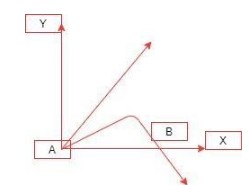
A velocity of a projectile at the initial point A is $ \left( 2\hat{i}+3\hat{j} \right) $ m/sec . Its velocity in $ \left( m/\sec \right) $ at point B is:

(A) $ -2\hat{i}-3\hat{j} $
(B) $ -2\hat{i}+3\hat{j} $
(C) $ 2\hat{i}-3\hat{j} $
(D) $ 2\hat{i}+3\hat{j} $

Answer
537.6k+ views
Hint: As the projectile is moving in downward direction. Therefore the component reverses its direction and its sign changes. The x-component remains the same.
Complete step by step solution
Consider that the projectile is fired from point A which is the initial point.
As the projectile moves, it covers distance along the horizontal due to the velocity of projection and along vertical in downwards direction due to the velocity attained under the effect of gravity.
Now, if we neglect friction due to air, then velocity of the projectile along horizontal will remain constant. So, the x component remains the same at point B, that is $ 2\hat{i} $ m/sec.
Now, when we talk about the motion along vertical, at point B the direction of y component changes and so the sign reverses, that is, it becomes $ -3\hat{j} $ m/sec.
So, the velocity at point B becomes $ \left( 2\hat{i}-3\hat{j} \right) $ m/sec.
So, the correct option is (C).
Note
Any object projected into space or air, such that it moves under the effect of gravity is called a projectile.
When projectile is fired parallel to horizontal, the equation of motion along horizontal is given as:
$ \begin{align}
& x=ut \\
& t=\dfrac{x}{u} \\
\end{align} $
Motion along vertical is given by:
$ \begin{align}
& y=\dfrac{1}{2}g{{t}^{2}} \\
& \text{ }=\dfrac{1}{2}g{{\left( \dfrac{x}{u} \right)}^{2}} \\
& y=\dfrac{g{{x}^{2}}}{2{{u}^{2}}} \\
\end{align} $
When projectile is fired at an angle to horizontal equation of motion along horizontal is
$ \begin{align}
& x=\left( u\cos \theta \right)t \\
& t=\dfrac{x}{u\cos \theta } \\
\end{align} $
Equation of motion along vertical is
$ y=\left( u\sin \theta \right)t+\dfrac{1}{2}g{{t}^{2}} $
When a projectile is thrown vertically upwards with velocity u, The time of flight of such a projectile is given by $ T=\dfrac{2\text{ }u\sin 90{}^\circ }{8}=\dfrac{2u}{8} $
When a projectile is at the highest point of its trajectory,
It possesses velocity only along horizontal.
The velocity and acceleration of the projectile are perpendicular to each other.
A projectile possesses same horizontal range, when it is projected at
Angle $ \theta $ with horizontal angle $ \theta $ with vertical.
Angle $ \theta $ or $ 90{}^\circ -\theta $ with horizontal.
Angle $ \left( 45{}^\circ +\theta \right) $ or $ \left( 45{}^\circ -\theta \right) $ with horizontal.
Complete step by step solution
Consider that the projectile is fired from point A which is the initial point.
As the projectile moves, it covers distance along the horizontal due to the velocity of projection and along vertical in downwards direction due to the velocity attained under the effect of gravity.
Now, if we neglect friction due to air, then velocity of the projectile along horizontal will remain constant. So, the x component remains the same at point B, that is $ 2\hat{i} $ m/sec.
Now, when we talk about the motion along vertical, at point B the direction of y component changes and so the sign reverses, that is, it becomes $ -3\hat{j} $ m/sec.
So, the velocity at point B becomes $ \left( 2\hat{i}-3\hat{j} \right) $ m/sec.
So, the correct option is (C).
Note
Any object projected into space or air, such that it moves under the effect of gravity is called a projectile.
When projectile is fired parallel to horizontal, the equation of motion along horizontal is given as:
$ \begin{align}
& x=ut \\
& t=\dfrac{x}{u} \\
\end{align} $
Motion along vertical is given by:
$ \begin{align}
& y=\dfrac{1}{2}g{{t}^{2}} \\
& \text{ }=\dfrac{1}{2}g{{\left( \dfrac{x}{u} \right)}^{2}} \\
& y=\dfrac{g{{x}^{2}}}{2{{u}^{2}}} \\
\end{align} $
When projectile is fired at an angle to horizontal equation of motion along horizontal is
$ \begin{align}
& x=\left( u\cos \theta \right)t \\
& t=\dfrac{x}{u\cos \theta } \\
\end{align} $
Equation of motion along vertical is
$ y=\left( u\sin \theta \right)t+\dfrac{1}{2}g{{t}^{2}} $
When a projectile is thrown vertically upwards with velocity u, The time of flight of such a projectile is given by $ T=\dfrac{2\text{ }u\sin 90{}^\circ }{8}=\dfrac{2u}{8} $
When a projectile is at the highest point of its trajectory,
It possesses velocity only along horizontal.
The velocity and acceleration of the projectile are perpendicular to each other.
A projectile possesses same horizontal range, when it is projected at
Angle $ \theta $ with horizontal angle $ \theta $ with vertical.
Angle $ \theta $ or $ 90{}^\circ -\theta $ with horizontal.
Angle $ \left( 45{}^\circ +\theta \right) $ or $ \left( 45{}^\circ -\theta \right) $ with horizontal.
Recently Updated Pages
Why is there a time difference of about 5 hours between class 10 social science CBSE

In cricket, what is a "pink ball" primarily used for?

In cricket, what is the "new ball" phase?

In cricket, what is a "death over"?

What is the "Powerplay" in T20 cricket?

In cricket, what is a "super over"?

Trending doubts
What is meant by exothermic and endothermic reactions class 11 chemistry CBSE

Which animal has three hearts class 11 biology CBSE

10 examples of friction in our daily life

One Metric ton is equal to kg A 10000 B 1000 C 100 class 11 physics CBSE

1 Quintal is equal to a 110 kg b 10 kg c 100kg d 1000 class 11 physics CBSE

Difference Between Prokaryotic Cells and Eukaryotic Cells




